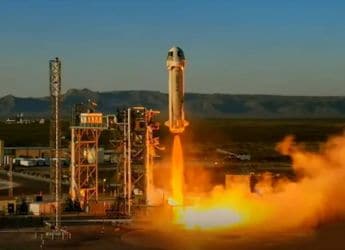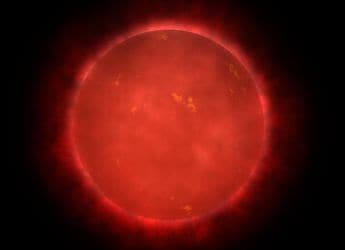- Home
- Science
- Science News
- NASA Observes Rare Uranus Occultation, Unveiling New Atmospheric and Ring Details
NASA Observes Rare Uranus Occultation, Unveiling New Atmospheric and Ring Details
NASA observed Uranus passing before a distant star, uncovering new details about its atmosphere and rings.

Photo Credit: NASA/Advanced Concepts Laboratory
NASA’s Uranus occultation observations reveal changes in its atmosphere since 1996
NASA's astronomers got a rare chance to study Uranus when the planet moved in front of a distant star — a rare event called a "stellar occultation." The occultation of Uranus occurred the morning of the April 7th and lasted for one hour. The occulation was visible from western North America and it was the first bright Uranian occultation since 1996. The Langley NASA Research Centre mobilised an international team of more than 30 scientists who combined observations from 18 observatories to gather important facts. The contribution of these two groups, together, led to phase coverage being restored and was key to the possibility of investigating the vertical structure of its atmosphere.
NASA's Rare Uranus Occultation Unlocks New Atmospheric and Ring Discoveries
According to Space.com, planetary scientist William Saunders stressed the enormity of the effort and that it could not have been accomplished without the help of every telescope. “By observing this occultation from so many large telescopes at so many altitudes, we can determine the temperature structure of Uranus' atmosphere at a level of detail that was not possible before,” Saunders stated. As per NASA's official release, the newly gathered data could significantly advance plans for future Uranus exploration missions.
During the occultation, researchers measured the temperatures and chemical composition of Uranus' stratosphere, capturing changes unseen since the last event nearly three decades ago. Uranus is about 2 billion miles (3.2 billion kilometres) from Earth. Uranus has no firm surface; rather, it is covered by a swirling mass of water, ammonia, and methane clouds. This low-freezing-point substance is the slushy, icy layer that veneers a volumetric rocky mantle, which is surrounded by an atmosphere of mostly hydrogen and helium.
The scientists also observed that ice and gas giants like Uranus may be natural laboratories for learning about atmospheres. This absence of solid ground means that cloud formation, storm development, and connections between wind patterns are all part of a unified system— a kind of warm, wet, swirling ocean of air that we call the atmosphere.
This is according to postdoctoral researcher Emma Dahl of the California Institute of Technology. “We can find out why we have clouds, why we have storms, and why we have wind, not from the many thousands of objects that we have on the surface here on the Earth, but from the total atmosphere that we have over the mountain,” Dahl said in the NASA statement.
Over the next six years, Uranus will occult several dimmer stars, offering further chances to observe the process, according to NASA officials. But the next big event with a brighter star is expected in 2031, presenting yet another opportunity for astronomers to refine their ideas of this remote ice giant's highly active atmosphere and delicate rings.
Get your daily dose of tech news, reviews, and insights, in under 80 characters on Gadgets 360 Turbo. Connect with fellow tech lovers on our Forum. Follow us on X, Facebook, WhatsApp, Threads and Google News for instant updates. Catch all the action on our YouTube channel.
Related Stories
- Samsung Galaxy Unpacked 2025
- ChatGPT
- Redmi Note 14 Pro+
- iPhone 16
- Apple Vision Pro
- Oneplus 12
- OnePlus Nord CE 3 Lite 5G
- iPhone 13
- Xiaomi 14 Pro
- Oppo Find N3
- Tecno Spark Go (2023)
- Realme V30
- Best Phones Under 25000
- Samsung Galaxy S24 Series
- Cryptocurrency
- iQoo 12
- Samsung Galaxy S24 Ultra
- Giottus
- Samsung Galaxy Z Flip 5
- Apple 'Scary Fast'
- Housefull 5
- GoPro Hero 12 Black Review
- Invincible Season 2
- JioGlass
- HD Ready TV
- Laptop Under 50000
- Smartwatch Under 10000
- Latest Mobile Phones
- Compare Phones
- Huawei Nova 15
- Huawei Nova 15 Pro
- Huawei Nova 15 Ultra
- OnePlus 15R
- Realme Narzo 90x 5G
- Realme Narzo 90 5G
- Vivo S50 Pro Mini
- Vivo S50
- Asus ProArt P16
- MacBook Pro 14-inch (M5, 2025)
- OnePlus Pad Go 2 (5G)
- Infinix Xpad Edge
- OnePlus Watch Lite
- Just Corseca Skywatch Pro
- Acerpure Nitro Z Series 100-inch QLED TV
- Samsung 43 Inch LED Ultra HD (4K) Smart TV (UA43UE81AFULXL)
- Asus ROG Ally
- Nintendo Switch Lite
- Haier 1.6 Ton 5 Star Inverter Split AC (HSU19G-MZAID5BN-INV)
- Haier 1.6 Ton 5 Star Inverter Split AC (HSU19G-MZAIM5BN-INV)







![[Partner Content] OPPO Find X9 Two Week Experience: Here's Why It Stands Out](https://www.gadgets360.com/static/mobile/images/spacer.png)









